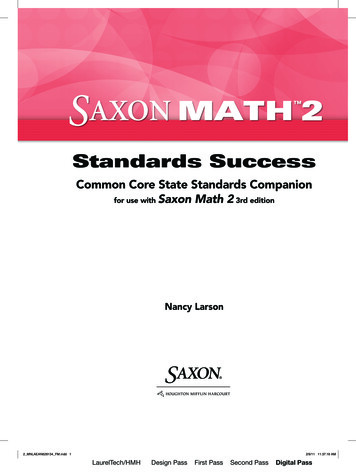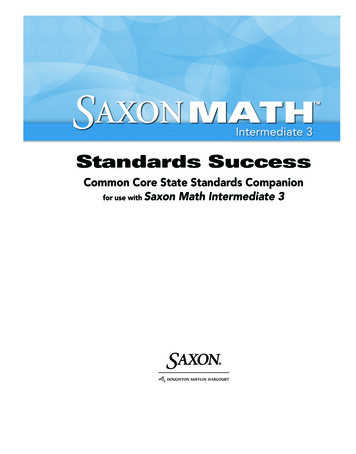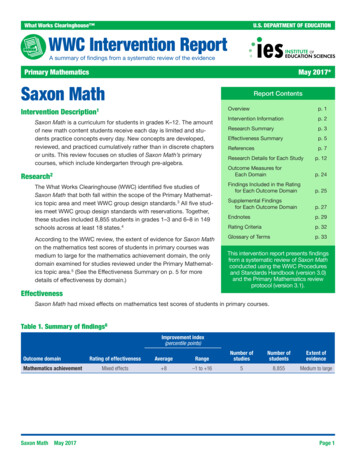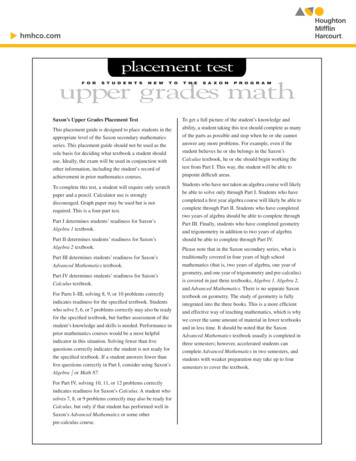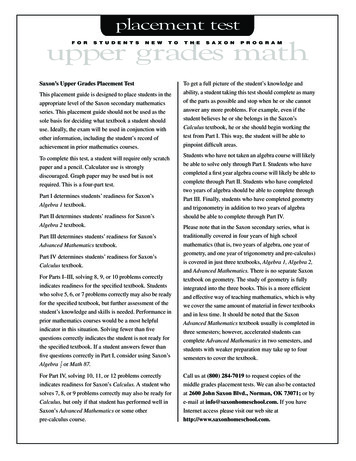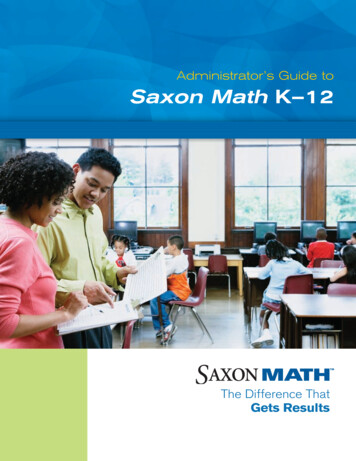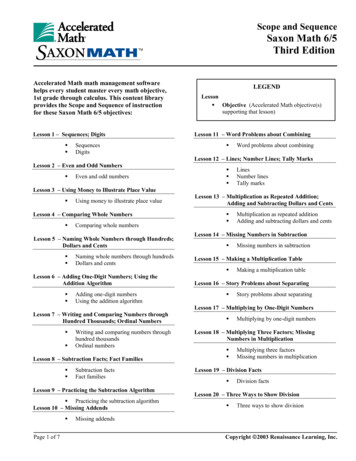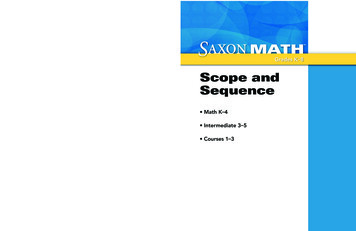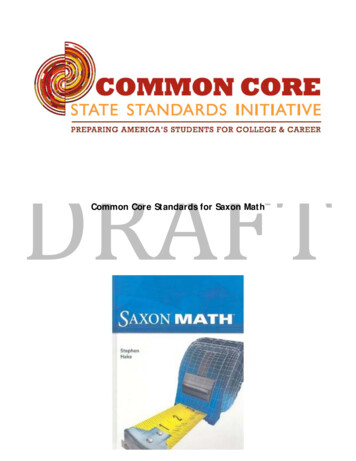
Transcription
Common Core Standards for Saxon Math
Standards for Mathematical PracticeCCSS.Math.Practice.MP1 Make sense of problems and persevere in solving them.CCSS.Math.Practice.MP2 Reason abstractly and quantitatively.CCSS.Math.Practice.MP3 Construct viable arguments and critique the reasoning of others.CCSS.Math.Practice.MP4 Model with mathematics.CCSS.Math.Practice.MP5 Use appropriate tools strategically.CCSS.Math.Practice.MP6 Attend to precision.CCSS.Math.Practice.MP7 Look for and make use of structure.CCSS.Math.Practice.MP8 Look for and express regularity in repeated reasoning.
Common Core Standards and Saxon Math Lessons Associated With Said Standards:Grade 5 » Number & Operations in Base TenCCSS.MATH.CONTENT.5.NBT.A.1Recognize that in a multi-digit number, a digit in one place represents 10 times as much as it representsin the place to its right and 1/10 of what it represents in the place to its left.Lesson: 3, 7, 52, 64, 106CCSS.MATH.CONTENT.5.NBT.A.2Explain patterns in the number of zeros of the product when multiplying a number by powers of 10,and explain patterns in the placement of the decimal point when a decimal is multiplied or divided by apower of 10. Use whole-number exponents to denote powers of 10.Lesson: 29, 64, 68, 78, 111, 118CCSS.MATH.CONTENT.5.NBT.A.3Read, write, and compare decimals to thousandths.CCSS.MATH.CONTENT.5.NBT.A.3.ARead and write decimals to thousandths using base-ten numerals, number names, and expanded form,e.g., 347.392 3 100 4 10 7 1 3 (1/10) 9 (1/100) 2 (1/1000).Lesson: 5, 64, 66, 67, 68, 69, 106CCSS.MATH.CONTENT.5.NBT.A.3.BCompare two decimals to thousandths based on meanings of the digits in each place, using , , and symbols to record the results of comparisons.Lesson: 69, 70, 71, 100, 106CCSS.MATH.CONTENT.5.NBT.A.4Use place value understanding to round decimals to any place.Lesson: 62, 64, 104, 106CCSS.MATH.CONTENT.5.NBT.B.5Fluently multiply multi-digit whole numbers using the standard algorithm.Lesson: 17, 29, 51, 55, 56
CCSS.MATH.CONTENT.5.NBT.B.6Find whole-number quotients of whole numbers with up to four-digit dividends and two-digit divisors,using strategies based on place value, the properties of operations, and/or the relationship betweenmultiplication and division. Illustrate and explain the calculation by using equations, rectangular arrays,and/or area models.Lesson: 54, 56, 92, 94CCSS.MATH.CONTENT.5.NBT.B.7Add, subtract, multiply, and divide decimals to hundredths, using concrete models or drawings andstrategies based on place value, properties of operations, and/or the relationship between addition andsubtraction; relate the strategy to a written method and explain the reasoning used.Lesson: 13, 17, 26, 29, 51, 54, 56, 73, 99, 102, 109, 110, 111, 117, 118, 119
Grade 5 » Operations & Algebraic ThinkingCCSS.MATH.CONTENT.5.OA.A.1Use parentheses, brackets, or braces in numerical expressions, and evaluate expressions with thesesymbols.Lesson: 24, 48, 49, 51, 52, 78, Inv. 4CCSS.MATH.CONTENT.5.OA.A.2Write simple expressions that record calculations with numbers, and interpret numerical expressionswithout evaluating them. For example, express the calculation "add 8 and 7, then multiply by 2" as 2 (8 7). Recognize that 3 (18932 921) is three times as large as 18932 921, without having tocalculate the indicated sum or product.Lesson: 13, 24, 49, 51, Inv. 8CCSS.MATH.CONTENT.5.OA.B.3Generate two numerical patterns using two given rules. Identify apparent relationships betweencorresponding terms. Form ordered pairs consisting of corresponding terms from the two patterns, andgraph the ordered pairs on a coordinate plane. For example, given the rule "Add 3" and the startingnumber 0, and given the rule "Add 6" and the starting number 0, generate terms in the resultingsequences, and observe that the terms in one sequence are twice the corresponding terms in the othersequence. Explain informally why this is so.Lesson: 1, Inv. 6
Grade 5 » Number & d and subtract fractions with unlike denominators (including mixed numbers) by replacing givenfractions with equivalent fractions in such a way as to produce an equivalent sum or difference offractions with like denominators. For example, 2/3 5/4 8/12 15/12 23/12. (In general, a/b c/d (ad bc)/bd.)Lesson: 116CCSS.MATH.CONTENT.5.NF.A.2Solve word problems involving addition and subtraction of fractions referring to the same whole,including cases of unlike denominators, e.g., by using visual fraction models or equations to representthe problem. Use benchmark fractions and number sense of fractions to estimate mentally and assessthe reasonableness of answers. For example, recognize an incorrect result 2/5 1/2 3/7, byobserving that 3/7 1/2.Lesson: 23, 39, 41, 43, 59, 60, 63, 75, 91, 116CCSS.MATH.CONTENT.5.NF.B.3Interpret a fraction as division of the numerator by the denominator (a/b a b). Solve word problemsinvolving division of whole numbers leading to answers in the form of fractions or mixed numbers,e.g., by using visual fraction models or equations to represent the problem. For example, interpret 3/4as the result of dividing 3 by 4, noting that 3/4 multiplied by 4 equals 3, and that when 3 wholes areshared equally among 4 people each person has a share of size 3/4. If 9 people want to share a 50pound sack of rice equally by weight, how many pounds of rice should each person get? Between whattwo whole numbers does your answer lie?Lesson: 20, 40, 43, 58, 91, 95CCSS.MATH.CONTENT.5.NF.B.4Apply and extend previous understandings of multiplication to multiply a fraction or whole number bya fraction.CCSS.MATH.CONTENT.5.NF.B.4.AInterpret the product (a/b) q as a parts of a partition of q into b equal parts; equivalently, as the resultof a sequence of operations a q b. For example, use a visual fraction model to show (2/3) 4 8/3, and create a story context for this equation. Do the same with (2/3) (4/5) 8/15. (In general,(a/b) (c/d) ac/bd.)Lesson: 46, 76, 86
CCSS.MATH.CONTENT.5.NF.B.4.BFind the area of a rectangle with fractional side lengths by tiling it with unit squares of the appropriateunit fraction side lengths, and show that the area is the same as would be found by multiplying the sidelengths. Multiply fractional side lengths to find areas of rectangles, and represent fraction products asrectangular areas.Lesson: 76CCSS.MATH.CONTENT.5.NF.B.5Interpret multiplication as scaling (resizing), by:CCSS.MATH.CONTENT.5.NF.B.5.AComparing the size of a product to the size of one factor on the basis of the size of the other factor,without performing the indicated multiplication.Lesson: 86CCSS.MATH.CONTENT.5.NF.B.5.BExplaining why multiplying a given number by a fraction greater than 1 results in a product greaterthan the given number (recognizing multiplication by whole numbers greater than 1 as a familiar case);explaining why multiplying a given number by a fraction less than 1 results in a product smaller thanthe given number; and relating the principle of fraction equivalence a/b (n a)/(n b) to the effect ofmultiplying a/b by 1.Lesson: 86CCSS.MATH.CONTENT.5.NF.B.6Solve real world problems involving multiplication of fractions and mixed numbers, e.g., by usingvisual fraction models or equations to represent the problem.Lesson: 76, 86, 120CCSS.MATH.CONTENT.5.NF.B.7Apply and extend previous understandings of division to divide unit fractions by whole numbers andwhole numbers by unit fractions.1
CCSS.MATH.CONTENT.5.NF.B.7.AInterpret division of a unit fraction by a non-zero whole number, and compute such quotients. Forexample, create a story context for (1/3) 4, and use a visual fraction model to show the quotient. Usethe relationship between multiplication and division to explain that (1/3) 4 1/12 because (1/12) 4 1/3.Lesson: 87, 95CCSS.MATH.CONTENT.5.NF.B.7.BInterpret division of a whole number by a unit fraction, and compute such quotients. For example,create a story context for 4 (1/5), and use a visual fraction model to show the quotient. Use therelationship between multiplication and division to explain that 4 (1/5) 20 because 20 (1/5) 4.Lesson: 87, 96CCSS.MATH.CONTENT.5.NF.B.7.CSolve real world problems involving division of unit fractions by non-zero whole numbers and divisionof whole numbers by unit fractions, e.g., by using visual fraction models and equations to represent theproblem. For example, how much chocolate will each person get if 3 people share 1/2 lb of chocolateequally? How many 1/3-cup servings are in 2 cups of raisins?Lesson 87
Grade 5 » Measurement & DataCCSS.MATH.CONTENT.5.MD.A.1Convert among different-sized standard measurement units within a given measurement system (e.g.,convert 5 cm to 0.05 m), and use these conversions in solving multi-step, real world problems.Lesson: 44, 46, 47, 65, 66, 74, 77, 85CCSS.MATH.CONTENT.5.MD.B.2Make a line plot to display a data set of measurements in fractions of a unit (1/2, 1/4, 1/8). Useoperations on fractions for this grade to solve problems involving information presented in lineplots. For example, given different measurements of liquid in identical beakers, find the amount ofliquid each beaker would contain if the total amount in all the beakers were redistributed equally.Lesson: 74, Inv. 5CCSS.MATH.CONTENT.5.MD.C.3Recognize volume as an attribute of solid figures and understand concepts of volume measurement.CCSS.MATH.CONTENT.5.MD.C.3.AA cube with side length 1 unit, called a "unit cube," is said to have "one cubic unit" of volume, and canbe used to measure volume.Lesson: 103CCSS.MATH.CONTENT.5.MD.C.3.BA solid figure which can be packed without gaps or overlaps using n unit cubes is said to have avolume of n cubic units.Lesson: 103CCSS.MATH.CONTENT.5.MD.C.4Measure volumes by counting unit cubes, using cubic cm, cubic in, cubic ft, and improvised units.Lesson: 103CCSS.MATH.CONTENT.5.MD.C.5Relate volume to the operations of multiplication and addition and solve real world and mathematicalproblems involving volume.
CCSS.MATH.CONTENT.5.MD.C.5.AFind the volume of a right rectangular prism with whole-number side lengths by packing it with unitcubes, and show that the volume is the same as would be found by multiplying the edge lengths,equivalently by multiplying the height by the area of the base. Represent threefold whole-numberproducts as volumes, e.g., to represent the associative property of multiplication.Lesson: 103, 104CCSS.MATH.CONTENT.5.MD.C.5.BApply the formulas V l w h and V b h for rectangular prisms to find volumes of rightrectangular prisms with whole-number edge lengths in the context of solving real world andmathematical problems.Lesson: 103, 104, 114CCSS.MATH.CONTENT.5.MD.C.5.CRecognize volume as additive. Find volumes of solid figures composed of two non-overlapping rightrectangular prisms by adding the volumes of the non-overlapping parts, applying this technique tosolve real world problems.Lesson: 103, 104, 114
Grade 5 » GeometryCCSS.MATH.CONTENT.5.G.A.1Use a pair of perpendicular number lines, called axes, to define a coordinate system, with theintersection of the lines (the origin) arranged to coincide with the 0 on each line and a given point inthe plane located by using an ordered pair of numbers, called its coordinates. Understand that the firstnumber indicates how far to travel from the origin in the direction of one axis, and the second numberindicates how far to travel in the direction of the second axis, with the convention that the names of thetwo axes and the coordinates correspond (e.g. x-axis and x-coordinate, y-axis and y-coordinate).Lesson: Inv. 8CCSS.MATH.CONTENT.5.G.A.2Represent real world and mathematical problems by graphing points in the first quadrant of thecoordinate plane, and interpret coordinate values of points in the context of the situation.Lesson: Inv. 6, Inv. 8CCSS.MATH.CONTENT.5.G.B.3Understand that attributes belonging to a category of two-dimensional figures also belong to allsubcategories of that category. For example, all rectangles have four right angles and squares arerectangles, so all squares have four right angles.Lesson: 32, 36, 45CCSS.MATH.CONTENT.5.G.B.4Classify two-dimensional figures in a hierarchy based on properties.Lesson: 32, 36, 45
Unit Layout:Unit 1: Number & Operations in Base Ten (Weeks 1‐7)Standards Applied Saxon Lessons:3, 5, 7, 13, 17, 26, 29, 52, 51, 54, 55, 56, 62, 64, 66, 67, 68, 69, 70, 71, 73, 78, 92, 94, 99, 100, 102,104, 106, 109, 110, 111, 117, 118, 119Goals: Students will understand how Base Ten is applied to all mathematical operations. Students will be able to explain how Base Ten is used in mathematical operations and reasoning.Big Idea: Base Ten operations are widely used in all mathematical process in everyday life. Base Ten is usedall around us. Computers, calculators, grocery stores, gas stations, banks, and many other avenuesuse Base Ten reasoning.Unit 2: Operations & Algebraic Thinking (Weeks 8‐11)Standards Taught:5.OA.A.15.OA.A.25.OA.B.3Applied Saxon Lessons:1, 13, 24, 48, 49, 51, 52, 78, Inv. 4, Inv. 6, Inv. 8Goals: Students will understand how algebraic thinking affects mathematical operations. Students will be able to explain how algebraic operations work and why they are important tofollow.Big Idea: There is an order to the world around us. There are also patterns all around us. Mathematics is builton principles of order and patterns.
Unit 3: Number & Operations—Fractions (Weeks 12‐22)Standards B.75.NF.B.7.A5.NF.B.7.B5.NF.B.7.CApplied Saxon Lessons:20, 23, 39, 40, 41, 43, 46, 58, 59, 60, 63, 75, 76, 86, 87, 91, 95, 96, 116, 120Goals: Students will understand how fractions work, how they are used in real world situations, and howto do mathematical operations using fractions. Students will be able to explain what fractions are and how they work in real world situations.Big Idea: Fractions are a part of life. There are many avenues that involve the use and understanding offractions. Baking, sewing, carpentry, construction, woodworking, financial systems, and many othervocations use fractions.
Unit 4: Measurement & Data (Weeks 22‐27)Standards lied Saxon Lessons:44, 46, 47, 65, 66, 74, 77, 85, 103, 104, 114, Inv. 5Goals: Students will understand the differences between the different types of measurement (cm, mm, m,in, ft, yd.). Students will be able to use different forms of measurements in real world situations. Students will be able to find the volume of multiple objects. Students will be able to explain how finding volume relates to other mathematical operations.Big Idea: Understanding measurement is a necessity in the real world. Everything uses a certain form ofmeasurement. The world uses a different system of measurement than the United States. The abilityto understand measurement will give students the ability to become multi faceted in world they livein.Unit 5: Geometry (Weeks 28‐35)Standards Taught:5.G.B.45.G.B.35.G.A.25.G.A.1Applied Saxon Lessons:32, 36, 45, Inv. 6, Inv. 8Goals: Students will be able to classify and explain shapes based on the shapes properties. Students will use real world situations to find, label, and graph ordered pairs in a coordinatesystem.Big Idea:
Geometric shapes and coordinate systems are used in a variety of vocations. Examples mightinclude: engineering, architecture, construction, stock markets, financial systems, etc.Unit Description:(There are 10 extra weeks for review, further study, extra support, or however teachers want to use them.)Unit 1, Week 1Standard Taught: 5.NBT.A.1Recognize that in a multi‐digit number, a digit in one place represents 10 times as much as itrepresents in the place to its right and 1/10 of what it represents in the place to its left. 5.NBT.A.3.ARead and write decimals to thousandths using base‐ten numerals, number names, and expandedform, e.g., 347.392 3 100 4 10 7 1 3 (1/10) 9 (1/100) 2 (1/1000).Lessons Applied:3, 5, 7, 52, 64, 66, 67, 68, 69, 106Goal: Students will understand that a numbers place value is 10 times as much as the number to its right,and 1/10 as much as the number to its left. Students will be able to read and write given numbers in numeric and word form up throughbillions and ten thousandths.Unit 1, Week 2Standard Taught: 5.NBT.A.2Explain patterns in the number of zeros of the product when multiplying a number by powers of 10,and explain patterns in the placement of the decimal point when a decimal is multiplied or divided bya power of 10. Use whole‐number exponents to denote powers of 10.Lessons Applied:29, 64, 68, 78, 111, 118Goal: Students will be able to explain how place value changes using powers of 10.Students will be able to explain patterns in the placement of the decimal point when the decimal ismultiplied or divided by 10.Students will be able to use whole‐number exponents to represent powers of 10.Unit 1, Week 3Standard Taught: 5.NBT.A.3Read, write, and compare decimals to thousandths. 5.NBT.A.3.BCompare two decimals to thousandths based on meanings of the digits in each place, using , , and symbols to record the results of comparisons.Lesson Applied:69, 70, 71, 100, 106
Goal: Students will be able to read, write, and compare decimals to thousandths. Students will be able to compare decimal numbers to thousandths using the symbols , , .Unit 1, Week 4Standards Taught: 5.NBT.A.4Use place value understanding to round decimals to any place.Lessons Applied:62, 64, 104, 106Goal: Students will be able to round decimal numbers to any place value using their understanding ofplace value.Unit 1, Week 5Standards Taught: 5.NBT.B.5Fluently multiply multi‐digit whole numbers using the standard algorithm. 5.NBT.B.6Find whole‐number quotients of whole numbers with up to four‐digit dividends and two‐digitdivisors, using strategies based on place value, the properties of operations, and/or the relationshipbetween multiplication and division. Illustrate and explain the calculation by using equations,rectangular arrays, and/or area models.Lessons Applied:17, 29, 51, 54, 55, 56, 92, 94Goal: Students will be able to multiply multi‐digit numbers using the standards algorithm. Students will be able to solve whole number division problems with up to four‐digit dividends andtwo‐digit divisors. Students will be able to show and explain their thinking using multiple models of arithmetic such asequations, arrays, and/or area models.Unit 1, Week 6Standards Taught: 5.NBT.B.7Add, subtract, multiply, and divide decimals to hundredths, using concrete models or drawings andstrategies based on place value, properties of operations, and/or the relationship between additionand subtraction; relate the strategy to a written method and explain the reasoning used.Lessons Applied:13, 17, 26, 29, 51, 54, 56, 73, 99, 102, 109, 110, 111, 117, 118, 119Goals: Students will be able to add, subtract, multiply, and divide decimal numbers to hundredths.
Students will be able to use concrete models or drawings to solve problems and equations.Students will be able to explain their reasoning and strategies they used to solve problems andequations.Unit 2, Week 1Standards Taught: 5.OA.A.1Use parentheses, brackets, or braces in numerical expressions, and evaluate expressions with thesesymbols.Lessons Applied:24, 48, 49, 51, 52, 78, Inv. 4Goals: Students will be able to properly evaluate mathematical expressions using parentheses, brackets, orbraces.Unit 2, Week 2Standards Taught: 5.OA.A.2Write simple expressions that record calculations with numbers, and interpret numericalexpressions without evaluating them. For example, express the calculation "add 8 and 7, thenmultiply by 2" as 2 (8 7). Recognize that 3 (18932 921) is three times as large as 18932 921,without having to calculate the indicated sum or product.Lessons Applied:13, 24, 49, 51, Inv. 8Goals: Students will be able to write and interpret numerical expression without having to calculate thesum or product.Unit 2, Week 3Standards Taught: 5.OA.B.3Generate two numerical patterns using two given rules. Identify apparent relationships betweencorresponding terms. Form ordered pairs consisting of corresponding terms from the two patterns,and graph the ordered pairs on a coordinate plane. For example, given the rule "Add 3" and thestarting number 0, and given the rule "Add 6" and the starting number 0, generate terms in theresulting sequences, and observe that the terms in one sequence are twice the corresponding terms inthe other sequence. Explain informally why this is so.Lessons Applied:1, Inv. 6 & Other ResourcesGoals: Students will be able to identify and generate patterns of corresponding terms.
Students will be able to form ordered pairs from two patterns and graph the ordered pairs on acoordinate plane.Unit 3, Week 1 & 2Standards Taught: 5.NF.A.1Add and subtract fractions with unlike denominators (including mixed numbers) by replacing givenfractions with equivalent fractions in such a way as to produce an equivalent sum or difference offractions with like denominators. For example, 2/3 5/4 8/12 15/12 23/12. (In general, a/b c/d (ad bc)/bd.) 5.NF.A.2Solve word problems involving addition and subtraction of fractions referring to the same whole,including cases of unlike denominators, e.g., by using visual fraction models or equations torepresent the problem. Use benchmark fractions and number sense of fractions to estimatementally and assess the reasonableness of answers. For example, recognize an incorrect result 2/5 1/2 3/7, by observing that 3/7 1/2.Lessons Applied:23, 39, 41, 43, 59, 60, 63, 75, 91, 116Goals: Students will be able add and subtract fractions by finding equivalent fractions, commondenominators, and using an algorithm. Students will solve word problems that involve the addition and subtraction of fractions. Students will explain and show their understanding through fractional models or equations.Unit 3, Week 3Standards Taught: 5.NF.B.3Interpret a fraction as division of the numerator by the denominator (a/b a b). Solve wordproblems involving division of whole numbers leading to answers in the form of fractions or mixednumbers, e.g., by using visual fraction models or equations to represent the problem. For example,interpret 3/4 as the result of dividing 3 by 4, noting that 3/4 multiplied by 4 equals 3, and that when 3wholes are shared equally among 4 people each person has a share of size 3/4. If 9 people want toshare a 50‐pound sack of rice equally by weight, how many pounds of rice should each person get?Between what two whole numbers does your answer lie?Lessons Applied:20, 40, 43, 58, 91, 95Goals: Students will understand that a fraction is another way of representing division. Students will be able to solve real world division word problems using whole numbers that leadthem to answers in the form of fractions or mixed numbers. Students will be able to show their thinking through visual models or equations and explain whytheir answer makes sense.
Unit 3, Week 4 & 5Standards Taught: 5.NF.B.4Apply and extend previous understandings of multiplication to multiply a fraction or whole numberby a fraction. 5.NF.B.4.AInterpret the product (a/b) q as a parts of a partition of q into b equal parts; equivalently, as theresult of a sequence of operations a q b. For example, use a visual fraction model to show (2/3) 4 8/3, and create a story context for this equation. Do the same with (2/3) (4/5) 8/15. (Ingeneral, (a/b) (c/d) ac/bd.) 5.NF.B.5.A Comparing the size of a product to the size of one factor on the basis of the size of the other factor,without performing the indicated multiplication. 5.NF.B.5.BExplaining why multiplying a given number by a fraction greater than 1 results in a product greaterthan the given number (recognizing multiplication by whole numbers greater than 1 as a familiarcase); explaining why multiplying a given number by a fraction less than 1 results in a productsmaller than the given number; and relating the principle of fraction equivalence a/b (n a)/(n b) to the effect of multiplying a/b by 1.Lessons Applied:46, 76, 86Goals: Students will understand that a product of a fraction and a whole number is a fraction of that wholenumber. Students will be able to create a story context for a multiplication problem using whole numbersand fractions. Students will be able to explain how multiplication with fractions work, and what happens whenwhole numbers are multiplied by fractions less than one and greater than one.Unit 3 Week 6Standards Taught: 5.NF.B.6Solve real world problems involving multiplication of fractions and mixed numbers, e.g., by usingvisual fraction models or equations to represent the problem.Lessons Applied:76, 86, 120Goals:
Students will be able to solve real world problems involving multiplication of fractions and wholenumbers.Students will be able to explain their thinking using visual models or equations.Unit 3, Week 7 & 8Standards Taught: 5.NF.B.7Apply and extend previous understandings of division to divide unit fractions by whole numbersand whole numbers by unit fractions.1 5.NF.B.7.AInterpret division of a unit fraction by a non‐zero whole number, and compute such quotients. Forexample, create a story context for (1/3) 4, and use a visual fraction model to show the quotient. Usethe relationship between multiplication and division to explain that (1/3) 4 1/12 because (1/12) 4 1/3. 5.NF.B.7.BInterpret division of a whole number by a unit fraction, and compute such quotients. For example,create a story context for 4 (1/5), and use a visual fraction model to show the quotient. Use therelationship between multiplication and division to explain that 4 (1/5) 20 because 20 (1/5) 4. 5.NF.B.7.CSolve real world problems involving division of unit fractions by non‐zero whole numbers anddivision of whole numbers by unit fractions, e.g., by using visual fraction models and equations torepresent the problem. For example, how much chocolate will each person get if 3 people share 1/2 lbof chocolate equally? How many 1/3‐cup servings are in 2 cups of raisins?Lessons Applied:87, 95, 96Goals: Students will be able to divide fractions by other fractions or whole numbers. Students will be able to create a story context for a division problem using whole numbers andfractions. Students will be able to explain how division of fractions work, and what happens when wholenumbers are divided by fractions less than one and greater than one.
Unit 4, Week 1Standards Taught: 5.MD.A.1Convert among different‐sized standard measurement units within a given measurement system(e.g., convert 5 cm to 0.05 m), and use these conversions in solving multi‐step, real world problems.Lessons Applied:44, 46, 47, 65, 66, 74, 77, 85Goals: Students will be able to convert among different‐sized measurement units within a givenmeasurement system. Students will be able to solve multi‐step, real world problems involving the conversion ofmeasurement units.Unit 4, Week 2Standards Taught: 5.MD.B.2Make a line plot to display a data set of measurements in fractions of a unit (1/2, 1/4, 1/8). Useoperations on fractions for this grade to solve problems involving information presented in lineplots. For example, given different measurements of liquid in identical beakers, find the amount ofliquid each beaker would contain if the total amount in all the beakers were redistributed equally.Lessons Applied:74, Inv. 5 & Other ResourcesGoals: Students will be able to create a line plot and display the data in fractions of a unit. Students will be able to find the mean of given data points.Unit 4, Week 3Standards Taught: 5.NF.B.4.BFind the area of a rectangle with fractional side lengths by tiling it with unit squares of theappropriate unit fraction side lengths, and show that the area is the same as would be found bymultiplying the side lengths. Multiply fractional side lengths to find areas of rectangles, andrepresent fraction products as rectangular areas.Lessons Applied:76 & Other Resources
Goals: Students will be able to find the area of a given object with fractional sides. Students will identify the area of an object as unit squares.Unit 4, Week 4 & 5Standards Taught: 5.MD.C.3Recognize volume as an attribute of solid figures and understand concepts of volume measurement. 5.MD.C.3.AA cube with side length 1 unit, called a "unit cube," is said to have "one cubic unit" of volume, andcan be used to measure volume. 5.MD.C.3.BA solid figure which can be packed without gaps or overlaps using n unit cubes is said to have avolume of n cubic units. 5.MD.C.4Measure volumes by counting unit cubes, using cubic cm, cubic in, cubic ft, and improvised units.Lessons Applied:103 & Other ResourcesGoals: Students will understand that volume is an attribute of a solid figure. Students will understand that volume is measured in “cubic units.” Students will be able to measure the volume of an object by counting unit cubes using a variety ofmeasurements.Unit 4, Week 6 & 7Standards Taught: 5.MD.C.5Relate volume to the operations of multiplication and addition and solve real world andmathematical problems involving volume. 5.MD.C.5.AFind the volume of a right rectangular prism with whole‐number side lengths by packing it withunit cubes, and show that the volume is the same as would be found by multiplying the edgelengths, equivalently by multiplying the height by the area of the base. Represent threefold whol
Common Core Standards and Saxon Math Lessons Associated With Said Standards: Grade 5 » Number & Operations in Base Ten CCSS.MATH.CONTENT.5.NBT.A.1 Recognize that in a multi-digit number, a digit in one place represents 10 times as much as it represents in the place to its right
